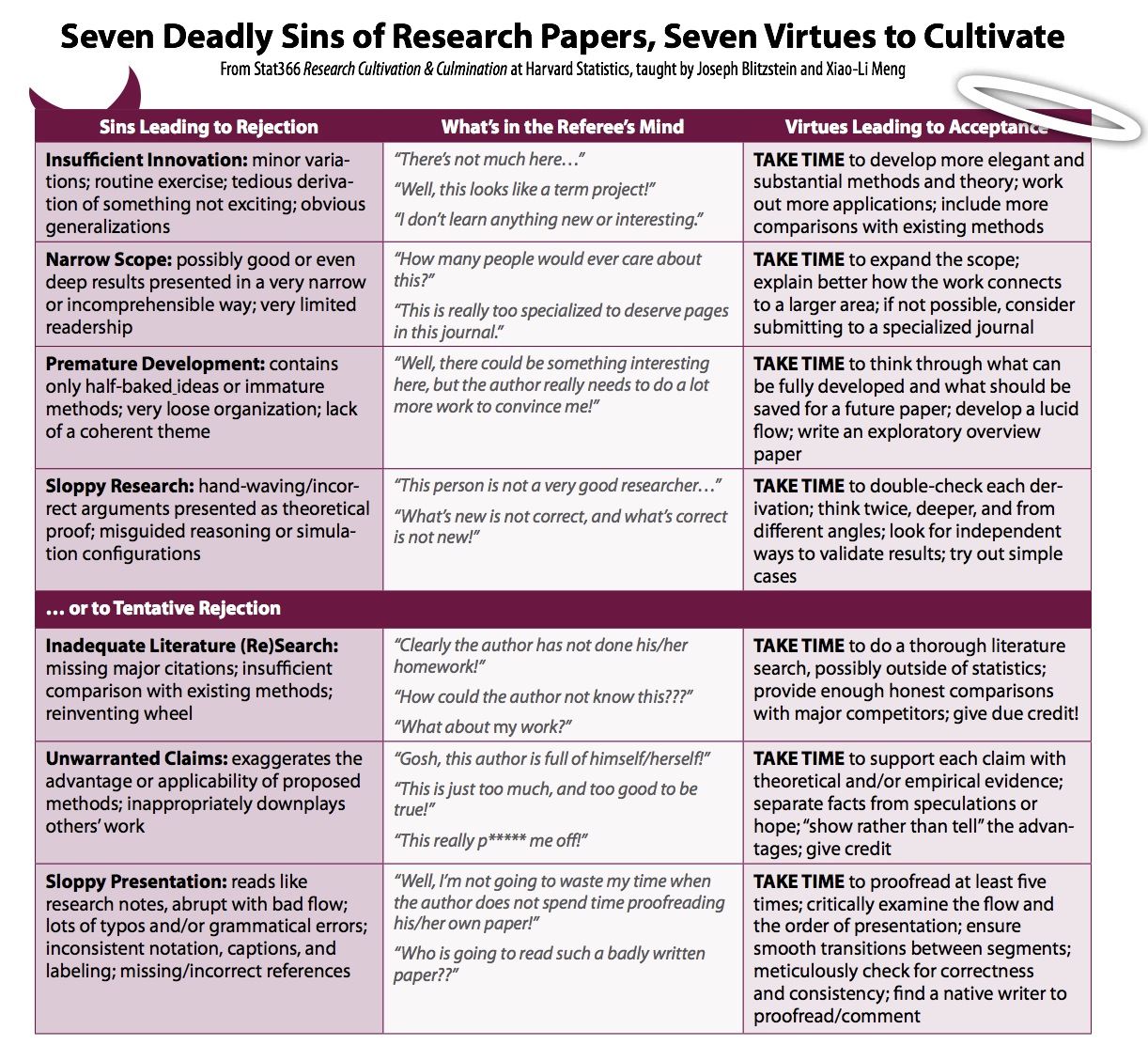Contributing Editor Xiao-Li Meng writes:
As an assistant professor in late 1995, working on a unit-root AR(1) model, I came across a cute way of calculating moments with negative or fractional powers by integrating—not differentiating—a moment-generating function (MGF). Like many junior researchers, I was eager to turn my findings into a publication. By January of 1996, “A Note on Finite-Sample Evaluations of Moments of Ratios” was ready for colleagues’ comments.
I love creative titles. But that was anything but creative! To make matters worse, my note started with “A Few Useful Lemmas,” and I submitted it to JASA. Clearly, I had little clue about JASA’s scope or its readership.
The rejection letter arrived in mid-April, three weeks after my submission. The letter reflected well the care that Editor George Casella and an Associate Editor (AE) had taken towards an inexperienced and impatient junior researcher:
“We both feel that the paper is really a nice piece of work, and the real task will be finding it the right home. (The associate editor’s letter to me was very complimentary of the paper.) My feeling is that your best shot might be Statistical Science. You probably will have to do a major revision, but it may be worth it. Good luck.”
I couldn’t possibly reject this rejection. They acted very promptly, and the AE’s report complimented appropriately the scholarship of the paper, but reasoned effectively that I chose a wrong journal: “Many JASA readers will stop right at the first line: ‘Some Useful Lemmas’.”
Did I learn the lesson? Well, not really. I took the suggestion to try Statistical Science (SS) but did not bother to revise. In my defense, I did not formally submit but rather sent it with a letter of inquiry, expressing my willingness to revise should the topic be found suitable for SS. Inquiring about suitability can be effective, but in this case it sent the rather unsubtle message that I was interested more in getting the paper published than actually improving the paper, a distinction that unfortunately I was not the only (junior) researcher to fail to appreciate. Consequently, SS’s rejection letter came within a week, together with a “Desiderata for Statistical Science,” a rather unsubtle message in return—do some homework before submitting!
Did I learn the lesson this time? Well, read on. During the next few months I extended the results from ratios to logarithms, and I felt the paper was substantial enough to drop the “note” distinction and submit it to the Annals of Statistics (AOS). The title was equally plain, “On Analytic Evaluations of Moments of Ratios and Logarithms”, and the paper still started with “A Few Useful Lemmas”—that may turn off JASA or SS readers, but surely it should turn on the AOS reviewers… shouldn’t it?
AOS’s rejection arrived in November of 1997, a year after my submission (perhaps a sign of serious interest by AOS’s reviewers?). The main reason for rejection was “although you have provided a very nicely written review and exposition, there is not enough that is new”. Again, I couldn’t declare this was an unjustified decision (for AOS). Whereas the logarithm results were new to the best of my knowledge, my initial “discovery” turned out to be known in the econometrics literature, though my article connected many dots and found some new applications.
My rejection pursuit therefore continued. I submitted it to International Statistical Review (ISR), in February of 1998, after a cosmetic revision. A “soft rejection” came in April 1998, suggesting reducing it to a “crisp note” focusing on the AR(1) application. So after all the trouble and time, I was back at square one!
The ISR’s reviewer report summarized well the reason for my ongoing rejection pursuit: “Although the author really does try hard, there is no clear purpose of this article.” Indeed, without a clear purpose, more effort can only lead to more rejections! Finally the message sank in: stop publication hunting, but think hard about what message I should, and could, get across.
Deep thinking takes time, and in this case it took five years. The next version, “From Unit Root to Stein’s Estimator to Fisher’s k Statistics: If You Have a Moment, I Can Tell You More…” was completed in September 2003, and by then it had a clear aim to fill in a missing chapter in textbooks’ treatments of MGFs. I was confident enough to re-submit it to SS (partly because George Casella had become its editor, so I was merely following his suggestion made seven years earlier!).
Taking my time paid off—the AE summarized the reviewers’ reaction as follows: “They called it lively, interesting, entertaining and cute.”
The article appeared in print in 2005, a decade after its conception.
Not every paper or project can afford such a long period of contemplation, nor should it. Perfectionism can turn to paralyzing procrastination. The five-year hiatus would be extreme for topics that are time-sensitive (and indeed I had plenty of those during those five years), but in this case it was a therapeutic reinforcement to resist the seduction of increased quantity at the risk of a reduction in quality. Indeed, the lessons I have learned as an author, reviewer and editor over two decades have convinced me that both our profession and we ourselves are better served if we all spend a bit more time on improving a rejected paper than on getting it published somewhere.
The “Seven Sins” course handout reproduced below was designed with that goal in mind (and it was distributed during the “Starting Research Career Panel” at JSM 2013).
So please, take your time. Publishing a paper may be hard, but un-publishing one is impossible.
Seven Deadly Sins of Research Papers, Seven Virtues to Cultivate [click for a bigger version]

Comments on “XL-Files: Rejection Pursuit”